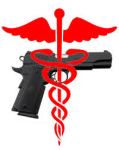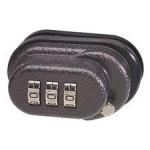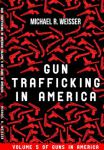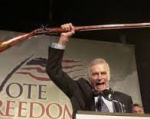Since 1999 there has been a nearly 30% decline in accidental gun deaths, with a 50% drop in deaths for children under 19. This is a remarkable decrease in unintentional gun mortality when you consider that during the same fifteen years, the civilian gun arsenal has probably increased by nearly 50%. So what’s going on? Are gun owners becoming more careful with their guns? Are gun manufacturers making guns that are more resistant to accidental discharges? Are gun safety programs working beyond anyone’s wildest dreams?
 If you listen to the NRA and the NSSF, they’ll tell you that their safety programs are simply the best and most effective that they can be. The NSSF runs a program called ChildSafe, which they claim is responsible for sending more than 36 million safety “kits” to more than 15,000 law enforcement agencies nationwide. The kits basically consist of a little brochure and a gun lock which are then handed out free of charge by the cops to anyone who walks through the door. The NSSF also sponsors occasional safety programs at participating retailers like BassPro, and has produced some thoroughly stupid videos telling parents how to sit around the dinner table and talk to their kids about guns.
If you listen to the NRA and the NSSF, they’ll tell you that their safety programs are simply the best and most effective that they can be. The NSSF runs a program called ChildSafe, which they claim is responsible for sending more than 36 million safety “kits” to more than 15,000 law enforcement agencies nationwide. The kits basically consist of a little brochure and a gun lock which are then handed out free of charge by the cops to anyone who walks through the door. The NSSF also sponsors occasional safety programs at participating retailers like BassPro, and has produced some thoroughly stupid videos telling parents how to sit around the dinner table and talk to their kids about guns.
The NRA safety program, Eddie Eagle, has been around since 1988, and its safety pamphlets and other teaching aids have “reached” 28 million schoolchildren, whatever the word ‘reached’ actually means. I’ll tell you what it means. It means that someone in Fairfax has mailed out 28 million pieces of paper to various schools around the United States. Maybe not just to schools; maybe to summer camps, maybe to the local VFW, maybe to this or that shooting range, maybe to who knows where. Back in 1991 a graduate nursing student looked at some gun safety programs and judged Eddie Eagle to have all the necessary content to teach good gun safety rules to kids. There was only one little problem: the author also stated that there had never been any study which could determine whether Eddie Eagle was effective as a teaching tool.
And that’s why programs like ChildSafe and Eddie Eagle can’t be taken seriously, for the simple reason that mailing out some literature on anything doesn’t mean that anyone actually received it, or read it, or changed their behavior in any way at all. The fact that safety brochures were being mailed to schools and gun locks were being mailed to police departments and gun mortality declined during the same years may appear to represent some kind of cause and effect, but nobody has ever conducted a study to see if these two factors are connected in any way, shape or form. And this connection becomes even more problematic when we include non-fatal shootings over the same period of years.
When we examine non-fatal accidental shootings, the five-year average between 2001-2006 and 2009-2013 drops by a whopping 7%. And remember how gun mortality for kids declined by 50%? For this same age group in terms of non-fatal accidents the number has basically remained the same since 2003. Now you can’t tell me that people who shoot themselves accidentally are aiming at less lethal parts of their bodies. What’s happening is that the same medical advances which result each year in a higher proportion of non-fatal gun assaults to fatal gun assaults is making unintentional gun injuries less lethal as well.
The NRA uses its Eddie Eagle program, among other things, to fight against doctors who want to caution patients about the risks presented by guns. They argue that a more effective process would be for doctors to distribute Eddie Eagle brochures. I would be the first person to stand up and loudly proclaim that Eddie Eagle should be adopted by every physician once the NRA conducts a valid before-and-after analysis to determine whether the program actually works. But don’t hold your breath – you may turn blue long before the NRA responds.





Recent Comments